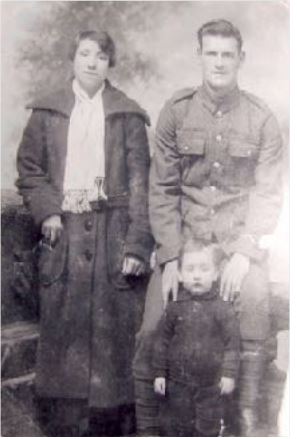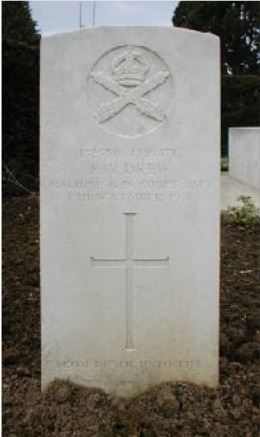2nd Battalion, Machine Gun Corps (Infantry)

Francis Wallace Drew, known as ‘Frank’, was born in Gloucester in 1887. His parents were George William Drew (1855-1914) and Martha (née Morgan: 1854-1904) and his siblings were George William H (born 1914), John Hope (1883), Henry (Harry) Alfred (1889), Thomas (Tom) Edwin (1893) and Laura Ann (1896).
At the time of the 1901 census the family lived at 10 Cross Keys Lane, in what is now central Gloucester. George William (senior) appears to have been a dock worker.
According to a Pension Record Card (PRC) which has survived at the National Archives, after leaving school Frank became a labourer and enlisted in the Gloucestershire Militia on 10 September 1903. On 7 January 1904 he enlisted in the Army, joining the Gloucestershire Regiment, with the number 7387. He stated his age to be 18 years and four months, which meant his 18th birthday would have been about September 1903, when, in fact, that would have been his 16th birthday. He initially signed on for three years ‘with the Colours’ and nine in the Reserve but in September 1905 he converted this into a full term with the Colours. His initial training was undertaken within the 3rd (Reserve) Battalion and on 7 June 1904 he was posted to the 2nd Battalion. On 25 October 1905 he transferred to the 1st Battalion and departed for India, where he was to spend just over five years, to 24 November 1910. It was then back to service in the UK (the 1911 census shows him serving at Portsmouth), until 7 January 1912, when he was transferred to the Army Reserve, suffering from a hernia and being unfit for further duty. Final discharge appears to have been on 22 August 1914, with a good conduct endorsement (notwithstanding being on a couple of charges of drunkenness early in his career). During his time with the Glosters he served for three years as a hospital orderly and four with the Regimental Police.
After transferring to the Army Reserve, he married Charlotte Thomas (born 1892) on 15 December 1912, at the Parish Church of St John the Baptist, Gloucester. They had a son, Francis Wallace in 1913 but he sadly died in the second half of 1914. At the time of his baptism in November 1913, the family lived at 10 Suffolk Street, Gloucester. A further son followed on 24 June 1915; he was to live into his 70s. A recently released PRC does give a hint that Charlotte Drew may have died on or about the end of the Great War and that young Francis passed into the care of a relative (an Ethel Staite) but this cannot be substantiated.
Very little evidence survives of Frank’s Great War service in the Machine Gun Corps (MGC) (Infantry). His number, 132550, indicates that he joined the Corps on or about 25 January 1918 and was probably sent to France in March 1918. It is not known if he was conscripted or volunteered and although it was usual for those joining the MGC to have initially served in another unit, possibly this was waived due to his previous Army background. His unit, 2nd Battalion, was formed on 4 March 1918, when all the machine gun companies in 2nd Division were amalgamated into one Machine Gun battalion. Second Division was involved in several of the major engagements of 1918, resisting the German Spring Offensive and participating in the Advance to Victory from 8 August 1918.
Frank’s entry in the Medal Roll for the MGC states that he died of pneumonia (probably a victim of the influenza pandemic raging at the time). A notice of death appearing in the Gloucester Journal of 16 November 1918 states that death occurred at the Red Cross Hospital in Gloucester. This is confirmed on the above-mentioned PRC (which also states the pneumonia was contracted on active service) and in the Register of Soldiers’ Effects, held at the National Army Museum. He died on 11 November 1918, aged 32, the day the Armistice came into force. Was he in hospital as a result of wounds or sickness? We shall probably never know. Francis Wallace Drew was buried in Gloucester Old Cemetery, where a standard CWGC headstone marks his grave
All the five Drew brothers served in the Great War and only one survived. George William served as a Private (5472) with the 1st Battalion, Gloucestershire Regiment and was killed in action on 21 December 1 9 1 4 : he has no known grave and is commemorated on the Le Touret Memorial to the Missing. Thomas Edwin was serving as a Private (17459) with the 10th Battalion, Worcestershire Regiment when he was killed at La Boisselle, on 3 July 1916, the third day of the Somme Offensive. He also has no known grave and is commemorated on the Thiepval Memorial to the Missing. Henry Alfred, served as a Private (11252) with the 1/4th Battalion of the Glosters and was killed on 10 October 1917, during the Battles of Third Ypres (often referred to as Passchendaele) and is buried at Poelcapelle British Cemetery. The only survivor was John Hope, who joined the 10th Worcesters, as a Private (16856) on 2 September 1914 but was discharged on 8 February 1915, due to defective eyesight.

Researched by Graham Adams 17 November 2019
(Thanks to Graham Sacker for information regarding Frank Drew’s MGC service and for the photograph of him, his wife and probably second son)
